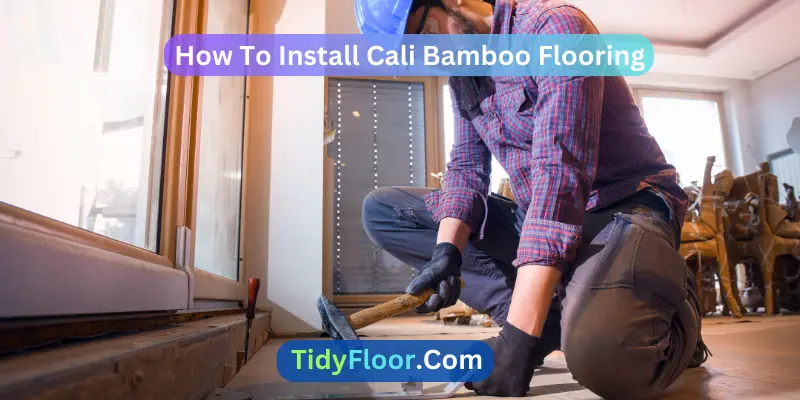Bamboo flooring is gaining popularity as an eco-friendly and stylish alternative to traditional hardwood floors. Cali Bamboo, a renowned brand in sustainable flooring solutions, offers a wide range of bamboo flooring options adding aesthetic appeal. However, if you want to install Cali bamboo, you must first learn how to install Cali bamboo flooring.
Installing Cali Bamboo flooring involves gathering materials and tools, acclimating the planks, preparing the subfloor, planning the layout, installing the first row snugly, continuing with staggered rows, trimming for edges, and finishing with baseboards.
If you’re considering installing Cali Bamboo flooring in your home, this step-by-step guide about installing bamboo flooring will walk you through the process, ensuring a successful and rewarding DIY project.
Before moving on to the steps, here is a list of materials you would need for Cali bamboo floor installation.
- Tape measure
- Safety goggles and ear protection
- Utility knife
- Cali Bamboo flooring planks
- Underlayment
- Adhesive (if required)
- Hammer and tapping block
- Circular saw or miter saw
- Spacers
- Chalk line
Time: A Few Days To a Week
Cost: Dollars 4 To 8
Install Cali Bamboo Flooring in 6 Step-by-Step Process: Easy Method
Cali bamboo flooring installation is simple and can be done smoothly if you know the right technique and have the tools needed. From my experience, I have discovered the right way of cali bamboo installation and in this guide, I have shared the exact steps.
Step 1: Acclimate the Flooring
Allow the Cali Bamboo flooring planks to acclimate to the room’s humidity and temperature for at least 72 hours. This helps prevent warping or other issues after installation.
Step 2: Prepare the Subfloor
Ensure that the subfloor is clean, dry, and level. Any imperfections or debris can affect the quality and stability of the installation. Lay down the underlayment, following the manufacturer’s instructions.
Step 3: Plan the Layout
Plan the layout of your Cali Bamboo flooring, considering the direction of natural light and the best visual flow of the planks. Use spacers along the walls to leave an expansion gap, allowing the flooring to adjust to temperature changes.
Step 4: Install the First Row
Begin by installing the first row of bamboo planks. Apply adhesive if necessary, and ensure the planks are snugly fit together. Use a tapping block and hammer to gently tap the planks into place, ensuring a tight and secure fit.
Step 5: Continue Installation
Work your way across the room, adding subsequent rows of Cali Bamboo planks. Stagger the joints between planks by a minimum of 6 inches for stability and aesthetics. Use a circular saw or miter saw to cut planks as needed, and remember to wear safety goggles and ear protection during cutting.
Step 6: Trim and Finish
As you approach the edges of the room, you may need to trim the last row of planks to fit. Measure and cut carefully, ensuring a precise fit. Once all planks are in place, remove spacers and install baseboards or molding to cover the expansion gap along the walls.
5 Tips About How to Install Cali Bamboo Vinyl Flooring
Installing Cali Bamboo vinyl flooring is a straightforward process that can transform your space with its beauty and durability. Whether you’re a seasoned DIY enthusiast or a beginner, these tips will guide you through the installation, ensuring a successful and long-lasting result.
1. Proper Preparation is Key
Before you begin the installation, ensure that the subfloor is clean, dry, and level. Any imperfections on the subfloor can affect the finished look and performance of the vinyl flooring. Use a leveling compound if necessary and make sure the surface is free from debris, dust, and moisture.
2. Installation Methods
Cali Bamboo vinyl flooring typically comes with a click-lock or adhesive installation method. For click-lock planks, simply connect the planks by angling and snapping them together. For adhesive installation, follow the manufacturer’s recommendations regarding the type of adhesive and application process. Use a roller to ensure proper adhesion.
3. Precision Cuts
When you reach the edges of the room or need to fit the planks around obstacles, accurate cuts are essential. Measure twice and cut once to avoid wastage. A utility knife or vinyl cutter can help achieve clean and precise cuts. Remember to account for the expansion gap when cutting planks that will be placed along the walls.
4. Finishing Touches
Once all the planks are installed, remove spacers and install baseboards or molding to cover the expansion gap. Use a nail gun or adhesive to secure the molding in place. Take your time to ensure the finishing touches are neat and aligned for a professional appearance.
5. Regular Maintenance
Cali Bamboo vinyl flooring is relatively low-maintenance. Regular sweeping or vacuuming and occasional mopping with a damp cloth are usually sufficient. Avoid using harsh chemicals or excessive water, as these can damage the flooring’s surface.
9 Mistakes to Avoid When Installing Cali Bamboo Flooring on Concrete
Installing Cali Bamboo flooring on concrete can be a fantastic way to bring elegance and sustainability to your space. However, working with concrete requires specific considerations to ensure a successful installation. Here are some common mistakes to avoid when installing Cali Bamboo flooring on concrete surfaces.
1. Skipping Moisture Testing
Concrete can retain moisture, which can lead to issues like warping, mold, and even adhesive failure. Skipping moisture testing is a grave mistake. Use a moisture meter to assess the concrete’s moisture levels. If they’re too high, it’s essential to address the issue before proceeding with installation.
2. Neglecting Proper Subfloor Preparation
Concrete subfloors must be properly prepared before installing Cali Bamboo flooring. Clean the surface thoroughly and ensure it’s level. Use a self-leveling compound if there are any uneven spots. A well-prepared subfloor is crucial for the flooring’s stability and longevity.
3. Not Using an Underlayment
An underlayment serves as a barrier between the concrete and the bamboo flooring. It helps with moisture protection, sound insulation, and added cushioning. Failing to use an appropriate underlayment can compromise the flooring’s performance and durability.
4. Incorrect Adhesive Application
If you’re using adhesive to install the bamboo flooring, it’s vital to apply it correctly. Follow the manufacturer’s recommendations for the type of adhesive and application process. Applying too much or too little adhesive can result in uneven flooring, gaps, or adhesive seepage.
5. Ignoring Expansion Gaps
Expansion gaps are necessary for all types of flooring, including bamboo. Neglecting to leave a sufficient gap between the bamboo flooring and the walls can lead to buckling and warping as the material expands and contracts with temperature changes.
6. Improper Installation Techniques
Whether you’re using a click-lock or adhesive installation method, following proper techniques is essential. Failing to interlock the planks correctly or not using the right adhesive application process can result in loose or uneven flooring.
7. Neglecting Finishing Touches
Just like any flooring installation, finishing touches matter. Not properly trimming and fitting the last row of planks, or neglecting to install proper baseboards, can result in an unfinished and unprofessional look.
8. Skipping Research
Each flooring type has its unique installation requirements. Skipping research specific to installing Cali Bamboo flooring on concrete can lead to costly mistakes. Take the time to understand the manufacturer’s guidelines and recommendations.
9. Not Seeking Professional Help
Installing bamboo flooring on concrete can be challenging, especially for beginners. If you’re unsure about any step of the process, it’s wise to seek professional help. Hiring an experienced installer can save you time, money, and potential headaches down the line.
FAQs:
How Long Does It Take To Acclimate Cali Bamboo Flooring?
Cali Bamboo recommends allowing the planks to acclimate for at least 72 hours in the room where they will be installed. This helps prevent warping due to changes in humidity and temperature.
Can I Install Cali Bamboo Flooring Over Existing Flooring?
Yes, you can install Cali Bamboo flooring over certain types of existing flooring, provided it’s level, dry, and clean. However, it’s essential to follow Cali Bamboo’s guidelines and use appropriate underlayment.
Do I Need Special Tools For the Installation of Cali Bamboo?
While basic tools like a circular saw, tape measure, and hammer are necessary, some projects might require specialized tools like a tapping block and spacers to ensure proper installation and alignment.
Is Professional Cali Bamboo Installation Recommended?
While Cali Bamboo flooring is designed for DIY installation, hiring a professional installer can ensure a flawless finish, especially for intricate layouts and larger spaces, saving you time and effort.
Can Cali Bamboo Flooring Be Installed In Humid Environments?
Yes, Cali Bamboo flooring is suitable for humid environments. However, it’s crucial to maintain consistent humidity levels and follow Cali Bamboo’s installation guidelines to prevent potential issues.
Do I Need To Glue Down The Cali Bamboo Flooring Planks?
Gluing down the planks is not always necessary, as Cali Bamboo offers both glue-down and click-lock options. Follow the manufacturer’s recommendations for your specific type of flooring.
How Do I Clean And Maintain Cali Bamboo Flooring?
Regular cleaning with a soft broom or vacuum and a damp mop is sufficient for routine maintenance. Avoid excessive water and harsh cleaning agents to prevent damage.
Can Cali Bamboo Flooring Be Refinished Like Hardwood?
While Cali Bamboo flooring is quite durable, it’s not as thick as solid hardwood. Refinishing might be possible for some collections, but it’s recommended to consult Cali Bamboo’s guidelines and professionals for refinishing advice.
Can I Install Cali Bamboo Flooring In Below-Grade Areas?
Yes, many Cali Bamboo flooring options can be installed in below-grade areas, like basements. Make sure to choose a flooring type suitable for such environments and follow proper installation procedures.
Is There A Warranty For Cali Bamboo Flooring?
Yes, Cali Bamboo typically offers warranties ranging from 10 to 50 years, depending on the specific product. However, it’s essential to carefully review the warranty details and follow installation and maintenance guidelines to ensure its validity.
Conclusion
Knowing how to install Cali Bamboo flooring can help you enhance the beauty of your home while contributing to environmental conservation. By following this step-by-step guide, you can confidently embark on your DIY flooring project.
Remember to take your time, measure accurately, and pay attention to detail throughout the installation process. With patience and care, you’ll enjoy the elegance and comfort of your Cali Bamboo flooring for years to come.


